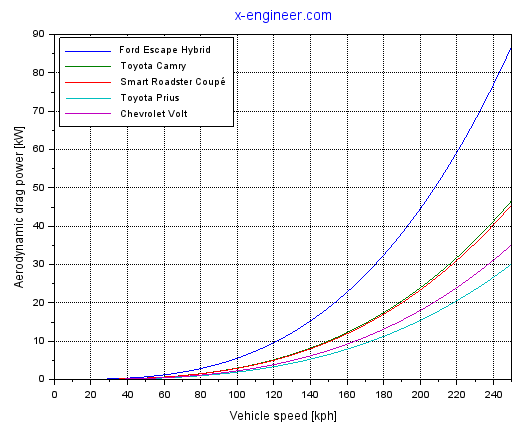
Any body which moves through a fluid (gas or liquid) is opposed by a resistance force called aerodynamic drag force. The same principle applies for road vehicles, when moving, due to the interaction with the surrounding air, a resistive force develops which tries to stop the vehicle from moving. This force, called aerodynamic drag force, increases in magnitude with the speed of the vehicle and depends on the shape and size of the car body.

Image: BMW Vision – Efficient Dynamics – Aerodynamics
Credit: BMW
Aerodynamic drag is an important aspect of the vehicle design because it has direct impact on the vehicle’s energy consumption and performance (especially at high speed).
When the vehicle is moving through the air, it creates a dynamic pressure in front of the vehicle, which further develops into a drag force. The aerodynamic drag force acting on a vehicle while moving is approximated by the formula [2]:
Fad = 0.5 · Cd · A · ρair · (v – vwind) 2Fad [N] – aerodynamic drag force
Cd [-] – aerodynamic drag coefficient
A [m 2 ] – maximum cross-section area of the vehicle
ρair [kg/m 3 ] – air density (equal to 1.202 kg/ m 3 for dry air at 20 °C and 101.325 kPa)
v [m/s] – vehicle speed
vwind [m/s] – wind speed
If we assume that there is no wind, equation (1) becomes:
Fad = 0.5 · Cd · A · ρair · v 2From equation (2), we can see that the aerodynamic drag force increases with the square of speed, therefore it becomes critically important at higher vehicle speeds.
The aerodynamic drag coefficient has a major influence on the aerodynamic drag force. In general, the drag coefficient can be defined as the aerodynamic quality of the shape of a body in a flow. Depending on the shape of the body, the drag coefficient can vary a lot.

Image: Aerodynamic drag coefficient for different shapes
The lower the drag coefficient, the lower the aerodynamic drag force of the vehicle, the higher the energy efficiency.
The optimal aerodynamic shape, which has the lower drag coefficient is the shape of a water drop (Cd = 0.04). Due to the air friction, the water drop is forced to take the shape which has lowest resistance in contact with the air, hence it has the lowest drag coefficient.
The drag coefficient depends on the body type of the vehicle and on the parts of the vehicle mounted on the exterior surfaces, like: roof rack, mud flaps, rear spoiler, side mirrors, radio antenna and windshield wipers. These parts disrupt the streamline shape of the vehicle and increase its drag coefficient.
From [4] we can list the drag coefficient for some common vehicles:
| Vehicle | Model Year | Cd [-] |
| Ford Escape Hybrid | 2005 | 0.400 |
| Toyota Camry | 1992 | 0.330 |
| Smart Roadster Coupé | 2003 | 0.380 |
| Toyota Prius | 2014 | 0.260 |
| Chevrolet Volt | 2014 | 0.281 |
The aerodynamic drag force is also influenced by the maximum frontal area of the vehicle A [m 2 ]. The frontal area of the vehicle is often given by the manufacturer or it can be approximated using a reference grid as in the picture below.

Image: Vehicle frontal area approximation
Credit: [5]
| Vehicle | Model Year | A [m 2 ] |
| Ford Escape Hybrid | 2005 | 1.080 |
| Toyota Camry | 1992 | 0.703 |
| Smart Roadster Coupé | 2003 | 0.596 |
| Toyota Prius | 2014 | 0.576 |
| Chevrolet Volt | 2014 | 0.622 |
Using equation (2) and data from the tables above, we can plot the aerodynamic drag force for vehicle speeds between 0 and 250 kph.

Image: Aerodynamic drag force for several vehicles
The aero drag force increases with the square of the vehicle speed. For this reason, especially at high vehicle speed (> 100 kph) aerodynamics has a critical importance in terms of vehicle performance and energy efficiency.
If we compare the aerodynamic drag force with the rolling resistance force, we can see that up to 100 kph they have similar value. At higher vehicle speeds the aerodynamic losses are far greater and they take a lot of traction force from the powertrain.
A better way of understanding the magnitude of the aerodynamic drag is by looking at the power consumption for aerodynamic losses. The aerodynamic drag power Pad [W] is calculated by multiplying the aerodynamic drag force Fad [N] with the vehicle speed v [m/s]:
Pad = Fad · vUsing equation (3), we can plot the aerodynamic drag power function of vehicle speed for example above:
 Aerodynamic drag power for several vehicles" width="524" height="428" />
Aerodynamic drag power for several vehicles" width="524" height="428" />
Image: Aerodynamic drag power for several vehicles
As expected, at high vehicle speed, the power losses due to air drag is significant. In many cases, the maximum vehicle speed is limited by the aerodynamic drag, since it consumes most of the wheel power and there is no power reserve for acceleration.
Calculate the aerodynamic drag force and power for a vehicle with the drag coefficient of 0.4 and frontal area of 1.08 m 2 , which is travelling at a speed of 100 kph.
Step 1. Convert vehicle speed from kph to m/s.
v = 100/3.6 = 27.78 m/sStep 2. Calculate the aerodynamic drag force using equation (2).
Fad = 0.5 · 0.4 · 1.08 · 1.202 · 27.78 2 = 200 NStep 3. Calculate the aerodynamic drag power using equation (3).